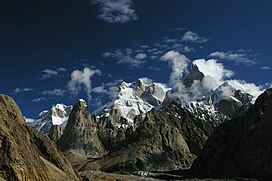geo.wikisort.org - Mountains
Baintha Brakk (Urdu: بائنتھا براک) or The Ogre is a steep, craggy mountain, 7,285 metres (23,901 ft) high, in the Panmah Muztagh, a subrange of the Karakoram mountain range. It is located in Gilgit-Baltistan, Pakistan.[2] It is famous for being one of the hardest peaks in the world to climb: twenty-four years elapsed between the first ascent in 1977 and the second in 2001.
| Baintha Brakk بائنتھا براک | |
|---|---|
| The Ogre | |
 Latok Peaks and the Ogre's thumb | |
| Highest point | |
| Elevation | 7,285 m (23,901 ft) Ranked 86th |
| Prominence | 1,891 m (6,204 ft)[1] |
| Listing | Ultra |
| Coordinates | 35°56′52″N 75°45′13″E |
| Geography | |
| Location | Gilgit-Baltistan, Pakistan |
| Parent range | Panmah Muztagh, Karakoram |
| Climbing | |
| First ascent | July 13, 1977 by Doug Scott and Chris Bonington |
| Easiest route | snow/ice climb |
Location
Baintha Brakk rises above the north side of the Biafo Glacier, one of the major glaciers of the central Karakoram. It lies about 75 kilometres (47 mi) north of Skardu, the major town of the region, and about 30 kilometres (19 mi) north of the roadhead at Askole.[3]
Notable features
Baintha Brakk is exceptional in its combination of altitude, height above local terrain, and steepness. It is a complex granite tower, steeper and rockier than most other Karakoram peaks. (The Latok peaks next to Baintha Brakk are similar, however.) For example, its South Face rises over 3,000 metres (9,800 ft) above the Uzun Brakk Glacier in only 2 km (1.24 mi) of horizontal distance.[4]
It is because of this steep, rocky nature that Baintha Brakk has been both so difficult to climb and so attractive a target for extremely high-level mountaineers.
Climbing history
Following two unsuccessful attempts in 1971 and 1976, the peak was first climbed by two Britons, Doug Scott and Chris Bonington, in 1977. (The other members of the party were Mo Anthoine, Clive Rowland, Nick Estcourt, and Tut Braithwaite. Estcourt, Anthoine, and Rowland all reached the lower West Summit, while Braithwaite was injured early on by rockfall.[5]) They climbed via the Southwest Spur to the West Ridge, and over the West Summit to the Main Summit. The ascent of the summit block required difficult rock climbing that extended the boundaries of what had been done at over 7,000 metres (23,000 ft).
The descent proved more dangerous still: On the first rappel from the summit, Scott broke both legs. Later, Bonington broke two ribs and contracted pneumonia. Also, much of the week-long descent to base camp was in a major storm. However, they were all able to reach base camp, where they had a long wait for assistance.[5]
The second ascent of Baintha Brakk was made by Urs Stöcker, Iwan Wolf, and Thomas Huber, on 21 July 2001, via the South Pillar route, following their first ascent of the subsidiary peak Ogre III (circa 6,800 metres [ 22,300 ft ]).[6] They note that there were more than 20 unsuccessful expeditions in the interim.[7] Mountain INFO magazine characterized their ascent as "arguably the most notable mountaineering achievement during the entire 2001 season."[8]
A third ascent by a new line on the peak's South Face was made by Americans Kyle Dempster and Hayden Kennedy on August 21, 2012. Compatriot Josh Wharton had also accompanied them on the climb but had to abandon the attempt at approximately 6800 meters (approximately 22,310 feet) due to altitude sickness.[9] Earlier in their trip the two had made another first ascent (along with Slovenian Urban Novak) of a new line on the massive east face of K7 (6,934 meters, 22,749 feet).[10]
See also
- List of mountains in Pakistan
- List of Ultras of the Karakoram and Hindu Kush
References
- "Karakoram ultra-prominent peaks". peaklist.org. Retrieved 2013-07-27.
- This region is disputed, and is claimed by India to be an integral part of the Indian state of Jammu and Kashmir.
- Orographical Sketch Map of the Karakoram by Jerzy Wala, 1990. Published by the Swiss Foundation for Alpine Research.
- DEM files for the Himalaya/Karakoram (Corrected versions of SRTM data)
- Andy Fanshawe and Stephen Venables, Himalaya Alpine-Style, Hodder and Stoughton, 1995, ISBN 0-340-64931-3.
- American Alpine Journal, 2001, p. 365
- The Himalayan Index Archived 2014-06-22 at the Wayback Machine lists only ten unsuccessful attempts; however the index is often incomplete. Its entry for the Ogre also mistakenly lists the second ascent as occurring in 2000.
- American Alpine Journal, 2001, p. 366
- "Ogre I, South Face, 2012 - Himalaya Masala". Archived from the original on 2013-03-20. Retrieved 2013-03-13.
- K7, East Face, 2012 - Himalaya Masala
- Jill Neate, High Asia: An Illustrated History of the 7000 Metre Peaks, ISBN 0-89886-238-8.
External links
- "Baintha Brakk". Peakware.com. Archived from the original on 2016-03-04.
На других языках
[de] Ogre (Berg)
Der Ogre (eigentlich Baintha Brakk, gesprochen etwa Benta Brak) ist ein 7285 m hoher Berg im pakistanisch kontrollierten Teil des Karakorum bzw. der umstrittenen Region Kaschmir.- [en] Baintha Brakk
[fr] L'Ogre
L'Ogre, surnom du Baintha Brakk, est un sommet pakistanais situé dans le Karakoram.[ru] Баннтха-Бракк
Баннтха-Бракк[2], Байнта-Брак, или О́гре (Baintha Brakk, The Ogre — англ. Людоед; урду بائنتھا براک) (7285 м) — остроконечная, сильно изрезанная вершина с причудливым рельефом. Наивысшая вершина хребта Панмах-Музтаг[en], в Каракоруме. 87-я по высоте в мире. Известна как одна из труднейших вершин мира: между первым удачным восхождением в 1977 году и последующим в 2001 прошло 24 года.Другой контент может иметь иную лицензию. Перед использованием материалов сайта WikiSort.org внимательно изучите правила лицензирования конкретных элементов наполнения сайта.
WikiSort.org - проект по пересортировке и дополнению контента Википедии

